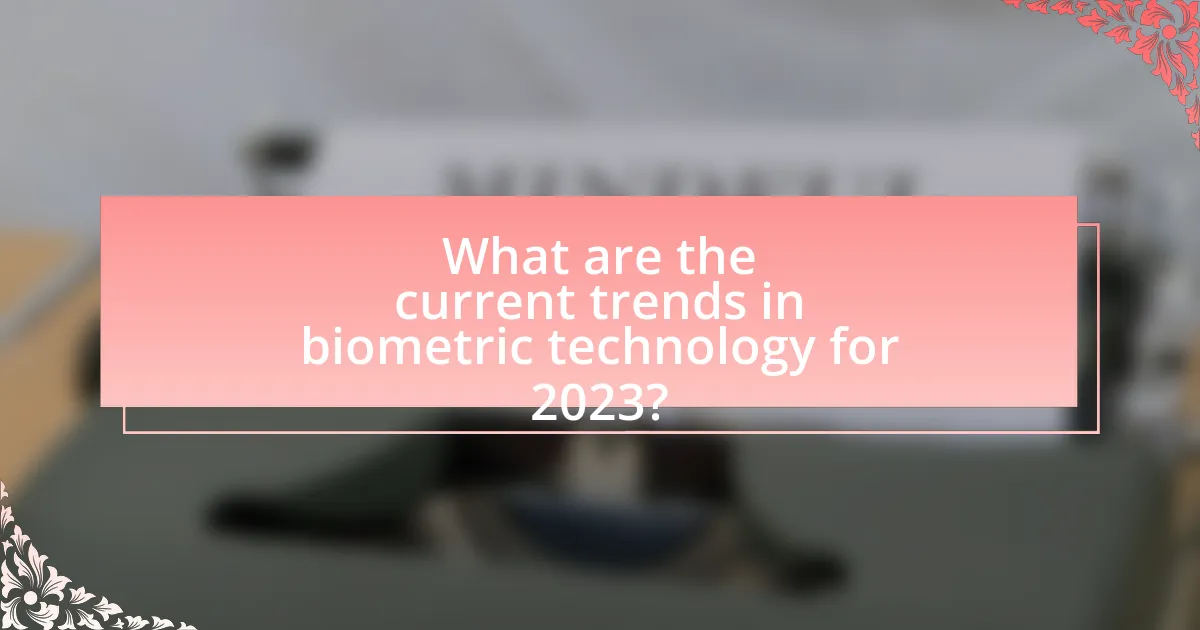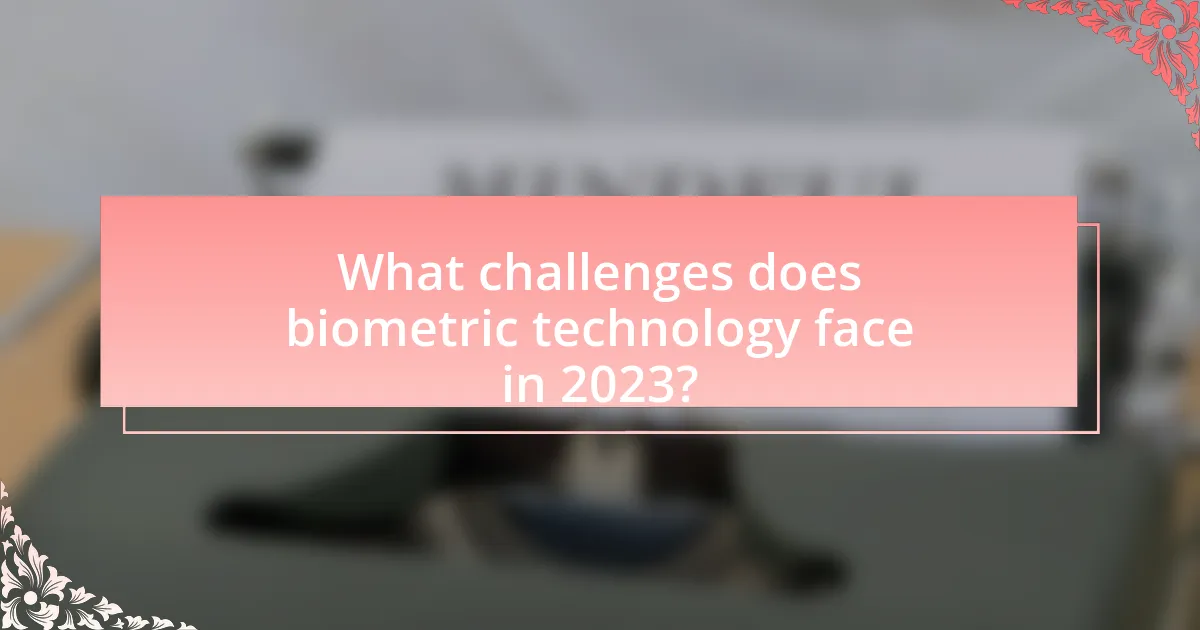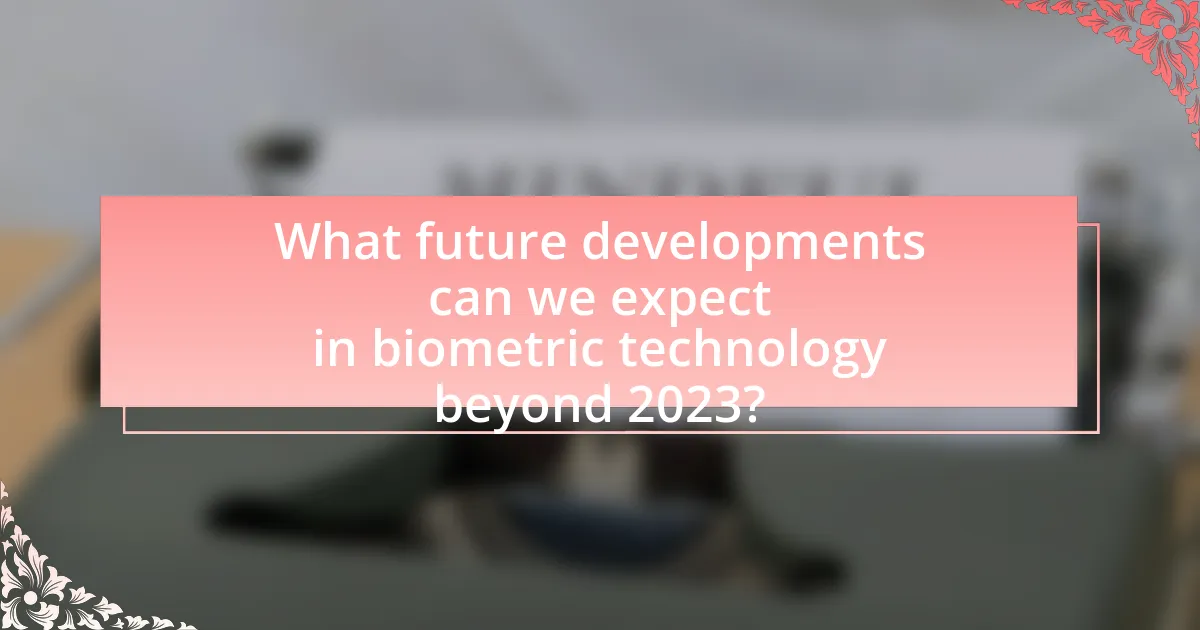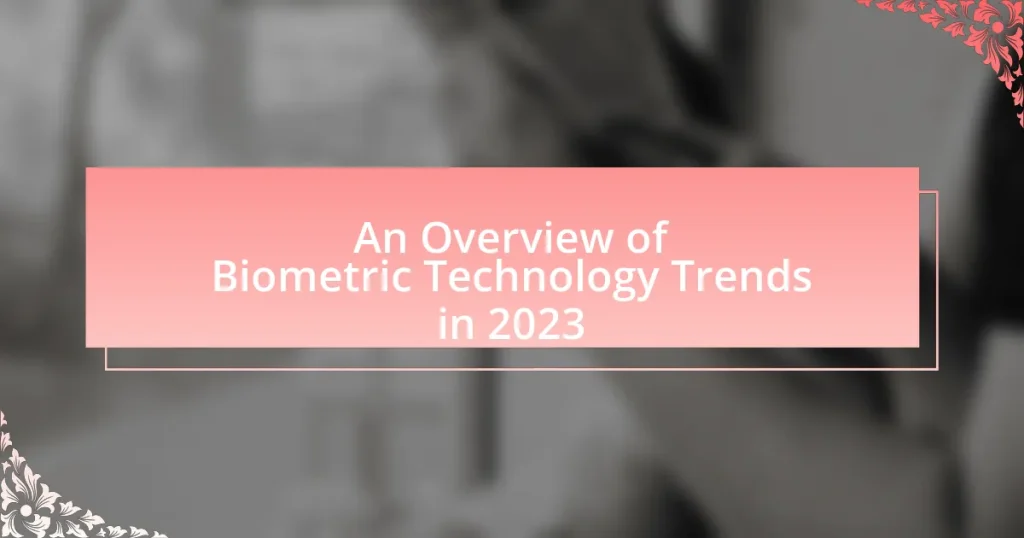The article provides a comprehensive overview of biometric technology trends in 2023, highlighting the increased adoption of multimodal biometric systems that enhance security and accuracy through the integration of various biometric identifiers. It discusses advancements in artificial intelligence and machine learning that improve the performance of biometric systems, as well as the growing integration of these technologies in mobile devices and wearables. Key applications in sectors such as healthcare, finance, and security are examined, alongside challenges related to privacy and data security. The article also explores future developments, including the role of blockchain and the Internet of Things in securing biometric data, and outlines best practices for organizations implementing biometric solutions.

What are the current trends in biometric technology for 2023?
Current trends in biometric technology for 2023 include the increased adoption of multimodal biometric systems, which combine multiple biometric identifiers such as fingerprints, facial recognition, and iris scans to enhance security and accuracy. Additionally, advancements in artificial intelligence and machine learning are improving the performance of biometric systems, enabling faster and more reliable identification processes. The integration of biometric technology in mobile devices and wearables is also on the rise, with features like facial recognition and fingerprint scanning becoming standard for user authentication. Furthermore, privacy concerns are driving the development of decentralized biometric systems that allow users to control their own biometric data. These trends are supported by market research indicating a projected growth of the biometric market, expected to reach $59.31 billion by 2025, reflecting the increasing reliance on biometric solutions across various sectors.
How is biometric technology evolving in 2023?
Biometric technology is evolving in 2023 through advancements in accuracy, speed, and integration with artificial intelligence. Innovations such as multimodal biometrics, which combine various biometric identifiers like facial recognition and fingerprint scanning, enhance security and user experience. Additionally, the adoption of AI algorithms improves the efficiency of biometric systems, allowing for faster processing and higher accuracy rates. For instance, a report by MarketsandMarkets indicates that the global biometric market is projected to grow from $34.4 billion in 2023 to $59.4 billion by 2028, reflecting the increasing reliance on biometric solutions across various sectors, including finance, healthcare, and security.
What advancements have been made in biometric recognition methods?
Recent advancements in biometric recognition methods include the integration of artificial intelligence (AI) to enhance accuracy and speed in identification processes. AI algorithms have improved facial recognition systems, enabling them to achieve over 99% accuracy in various lighting conditions and angles, as demonstrated by studies from the National Institute of Standards and Technology (NIST). Additionally, advancements in multi-modal biometric systems, which combine different biometric traits such as fingerprints, facial recognition, and iris scans, have increased security and reduced false acceptance rates. The use of deep learning techniques has also facilitated real-time processing of biometric data, making systems more efficient and user-friendly.
How are artificial intelligence and machine learning influencing biometric technology?
Artificial intelligence and machine learning are significantly enhancing biometric technology by improving accuracy, speed, and security in identification processes. These technologies enable advanced algorithms to analyze biometric data, such as facial recognition and fingerprint scanning, with greater precision. For instance, AI-driven systems can learn from vast datasets, allowing them to adapt to variations in biometric traits, which reduces false acceptance and rejection rates. According to a report by MarketsandMarkets, the global biometric system market is projected to grow from $30.2 billion in 2020 to $59.2 billion by 2025, driven largely by AI and machine learning advancements. This growth underscores the transformative impact of these technologies on biometric applications across various sectors, including security, healthcare, and finance.
What are the key applications of biometric technology in 2023?
The key applications of biometric technology in 2023 include identity verification, access control, and fraud prevention. Identity verification is widely utilized in sectors such as banking and travel, where biometric systems like fingerprint and facial recognition enhance security and streamline user experiences. Access control applications are prevalent in physical security, allowing organizations to restrict entry to authorized personnel through biometric authentication methods. Additionally, biometric technology plays a crucial role in fraud prevention, particularly in online transactions, where behavioral biometrics and voice recognition help detect and mitigate fraudulent activities. These applications are supported by advancements in machine learning and AI, which improve the accuracy and efficiency of biometric systems.
Which sectors are adopting biometric solutions most rapidly?
The sectors adopting biometric solutions most rapidly are healthcare, finance, and security. In healthcare, biometric systems enhance patient identification and streamline access to medical records, improving efficiency and reducing fraud. The finance sector utilizes biometric authentication for secure transactions and account access, with a notable increase in mobile banking applications incorporating fingerprint and facial recognition technologies. In security, biometric solutions are implemented for access control and surveillance, with organizations increasingly relying on fingerprint scanners and facial recognition systems to enhance safety measures. According to a report by MarketsandMarkets, the global biometric market is projected to grow significantly, driven by these sectors’ increasing demand for secure and efficient identification methods.
How is biometric technology enhancing security measures in various industries?
Biometric technology enhances security measures in various industries by providing unique identification methods that are difficult to forge or replicate. For instance, fingerprint recognition systems are widely used in banking and finance to prevent unauthorized access, with studies showing that biometric authentication can reduce fraud by up to 90%. Additionally, facial recognition technology is increasingly implemented in airports and public safety sectors to identify individuals on watchlists, improving security response times. The integration of iris scanning in healthcare facilities further ensures that patient records are accessed only by authorized personnel, thereby safeguarding sensitive information. These advancements demonstrate that biometric technology significantly strengthens security protocols across multiple sectors.

What challenges does biometric technology face in 2023?
Biometric technology faces several challenges in 2023, including privacy concerns, data security issues, and technological limitations. Privacy concerns arise from the potential misuse of biometric data, as individuals fear unauthorized access and surveillance. Data security issues are significant, as breaches can lead to the exposure of sensitive biometric information, which is difficult to change once compromised. Additionally, technological limitations, such as inaccuracies in recognition systems and the need for high-quality data input, hinder the effectiveness of biometric solutions. These challenges highlight the need for robust regulations and advancements in technology to ensure the safe and effective use of biometric systems.
What privacy concerns are associated with biometric data?
Biometric data raises significant privacy concerns primarily due to its unique and immutable nature. Unlike passwords or PINs, biometric identifiers such as fingerprints, facial recognition, and iris scans cannot be changed if compromised. This permanence increases the risk of identity theft and unauthorized access to personal information. Additionally, the collection and storage of biometric data often occur without explicit consent, leading to potential violations of individual privacy rights. Research by the Electronic Frontier Foundation highlights that biometric systems can be susceptible to hacking, which can expose sensitive personal data. Furthermore, the use of biometric data in surveillance systems raises ethical concerns regarding mass monitoring and the erosion of civil liberties.
How are regulations impacting the use of biometric technology?
Regulations are significantly impacting the use of biometric technology by imposing strict guidelines on data privacy and security. For instance, the General Data Protection Regulation (GDPR) in Europe mandates that organizations must obtain explicit consent from individuals before collecting biometric data, thereby limiting the scope of biometric applications. Additionally, various states in the U.S., such as Illinois with its Biometric Information Privacy Act (BIPA), require companies to implement stringent measures for data protection and provide transparency regarding data usage. These regulations not only enhance consumer trust but also compel businesses to invest in secure biometric systems, ultimately shaping the landscape of biometric technology deployment.
What measures are being taken to ensure data security in biometric systems?
Data security in biometric systems is ensured through multiple measures, including encryption, secure storage, and multi-factor authentication. Encryption protects biometric data during transmission and storage, making it unreadable to unauthorized users. Secure storage involves using hardware security modules or secure enclaves to safeguard sensitive information against breaches. Multi-factor authentication adds an additional layer of security by requiring users to provide multiple forms of verification, reducing the risk of unauthorized access. These measures are critical as they address vulnerabilities inherent in biometric systems, which are increasingly targeted by cyber threats.
How do user perceptions affect the adoption of biometric technology?
User perceptions significantly influence the adoption of biometric technology by shaping trust and acceptance levels. Positive perceptions, such as views on security and convenience, can lead to higher adoption rates, while negative perceptions, including concerns about privacy and data misuse, can hinder acceptance. For instance, a study by the International Journal of Information Management found that 70% of users expressed concerns about data security, which directly impacted their willingness to use biometric systems. Thus, addressing user perceptions through education and transparency is crucial for enhancing the adoption of biometric technology.
What factors influence consumer trust in biometric systems?
Consumer trust in biometric systems is influenced by factors such as perceived security, privacy concerns, system accuracy, and user experience. Perceived security relates to how safe consumers feel their biometric data is from unauthorized access or misuse. Privacy concerns arise from the potential for data breaches and the handling of sensitive personal information. System accuracy affects trust, as higher accuracy in biometric recognition reduces the likelihood of false positives or negatives, which can undermine confidence. Lastly, user experience encompasses the ease of use and convenience of biometric systems, which can enhance trust when users find the technology intuitive and reliable.
How can companies address user concerns regarding biometric data?
Companies can address user concerns regarding biometric data by implementing robust data protection measures and ensuring transparency in data usage. For instance, organizations can adopt encryption and secure storage solutions to protect biometric information from unauthorized access, which is crucial given that a 2021 report by the Ponemon Institute found that 60% of organizations experienced a data breach involving sensitive data. Additionally, companies should provide clear privacy policies that outline how biometric data is collected, used, and shared, fostering trust among users. Regular audits and compliance with regulations such as the General Data Protection Regulation (GDPR) can further demonstrate a commitment to safeguarding user privacy, as GDPR mandates strict guidelines for handling personal data, including biometric information.

What future developments can we expect in biometric technology beyond 2023?
Future developments in biometric technology beyond 2023 will likely include advancements in multi-modal biometrics, enhanced security measures, and increased integration with artificial intelligence. Multi-modal biometrics, which combines various biometric identifiers such as fingerprints, facial recognition, and iris scans, will improve accuracy and reduce false positives. Enhanced security measures will focus on anti-spoofing technologies to prevent fraudulent access, as evidenced by the growing concerns over biometric data theft. Additionally, the integration of AI will enable real-time analysis and decision-making, making biometric systems more efficient and responsive. These trends are supported by ongoing research and investment in biometric technologies, indicating a robust future for the field.
How will emerging technologies shape the future of biometrics?
Emerging technologies will significantly enhance the future of biometrics by improving accuracy, security, and user experience. Innovations such as artificial intelligence and machine learning will enable more sophisticated algorithms that can analyze biometric data with greater precision, reducing false positives and negatives. For instance, AI-driven facial recognition systems have shown a 99% accuracy rate in controlled environments, as reported by the National Institute of Standards and Technology. Additionally, advancements in sensor technology, such as 3D facial recognition and multispectral imaging, will allow for more reliable identification in diverse conditions, further solidifying biometrics as a secure authentication method. These technologies will also facilitate seamless integration into everyday devices, making biometric authentication more accessible and user-friendly.
What role will blockchain play in securing biometric data?
Blockchain will play a crucial role in securing biometric data by providing a decentralized and immutable ledger for storing and managing this sensitive information. This technology enhances security through encryption and ensures that biometric data, such as fingerprints or facial recognition patterns, cannot be altered or accessed without proper authorization. For instance, a study published in the journal “IEEE Access” highlights that blockchain can prevent unauthorized access and data breaches by allowing users to control their biometric data through private keys, thereby reducing the risk of identity theft.
How might biometric technology integrate with the Internet of Things (IoT)?
Biometric technology can integrate with the Internet of Things (IoT) by enabling secure authentication and access control across connected devices. This integration allows devices to use biometric data, such as fingerprints or facial recognition, to verify user identity before granting access to sensitive information or functionalities. For instance, smart home systems can utilize biometric sensors to ensure that only authorized users can control home automation features, enhancing security and user experience. According to a report by MarketsandMarkets, the biometric market is projected to grow significantly, indicating a rising trend in the adoption of biometric solutions within IoT ecosystems.
What best practices should organizations follow when implementing biometric technology?
Organizations should prioritize data privacy and security when implementing biometric technology. This involves conducting thorough risk assessments to identify vulnerabilities and ensuring compliance with regulations such as GDPR or CCPA. Additionally, organizations should implement multi-factor authentication to enhance security, as studies show that combining biometric data with other authentication methods significantly reduces the risk of unauthorized access. Regular audits and updates of biometric systems are essential to address emerging threats and maintain system integrity. Furthermore, organizations should provide clear communication and training for users to foster trust and understanding of biometric systems, as user acceptance is critical for successful implementation.
How can organizations ensure compliance with biometric data regulations?
Organizations can ensure compliance with biometric data regulations by implementing robust data governance frameworks that include clear policies, regular audits, and employee training. These frameworks should align with specific regulations such as the General Data Protection Regulation (GDPR) in Europe, which mandates explicit consent for data collection and processing, and the California Consumer Privacy Act (CCPA), which provides consumers with rights regarding their personal data. Regular audits help organizations assess their compliance status and identify areas for improvement, while employee training ensures that staff understand the importance of data protection and the specific regulations that apply to biometric data.
What strategies can enhance user acceptance of biometric systems?
To enhance user acceptance of biometric systems, organizations should prioritize transparency, user education, and robust security measures. Transparency involves clearly communicating how biometric data is collected, stored, and used, which builds trust among users. User education can demystify biometric technology, addressing concerns about privacy and security, thereby increasing comfort levels. Additionally, implementing strong security protocols, such as encryption and regular audits, reassures users that their data is protected, further promoting acceptance. Research indicates that when users feel informed and secure, their willingness to adopt biometric systems significantly increases, as evidenced by a study published in the Journal of Information Privacy and Security, which found that 78% of participants were more likely to use biometric systems when they understood the security measures in place.


